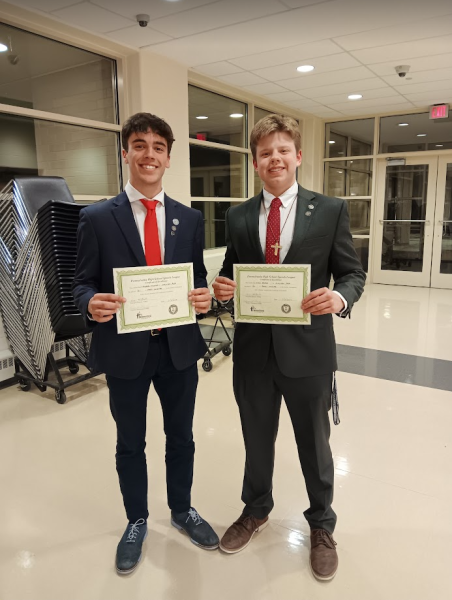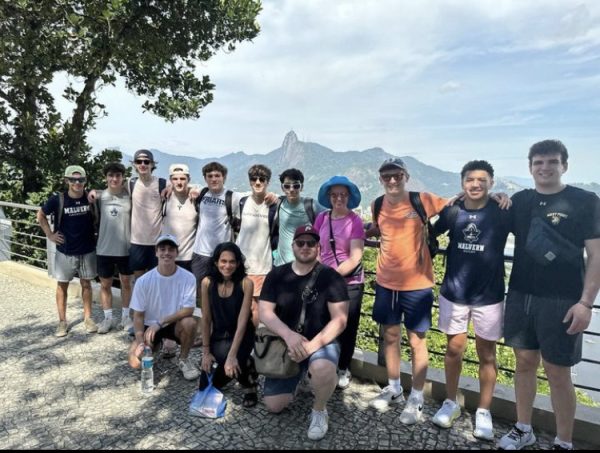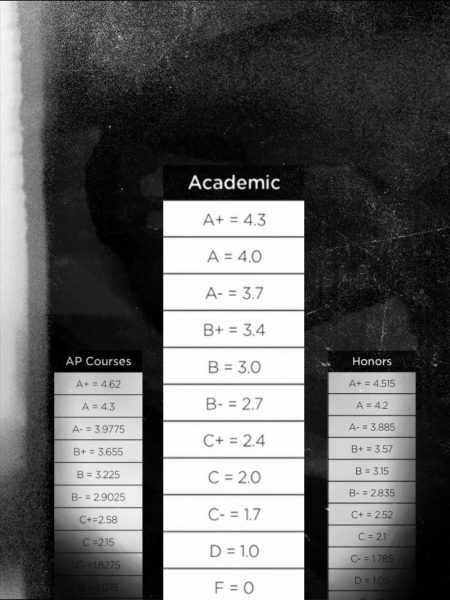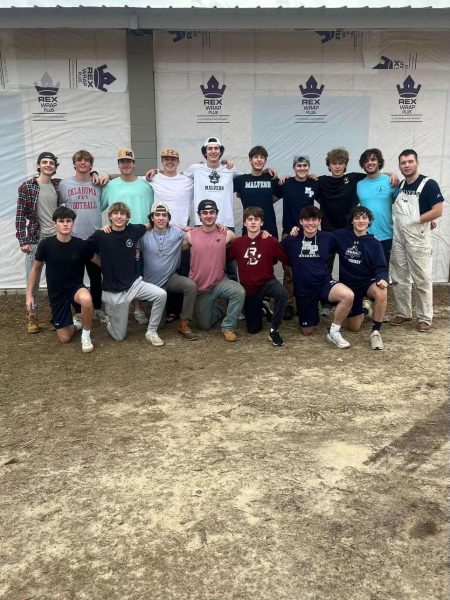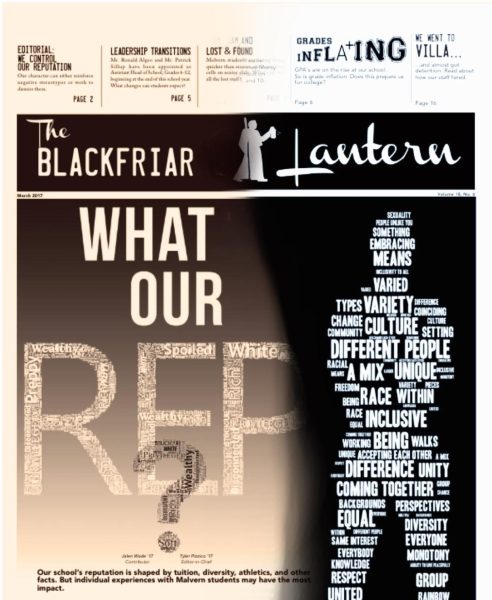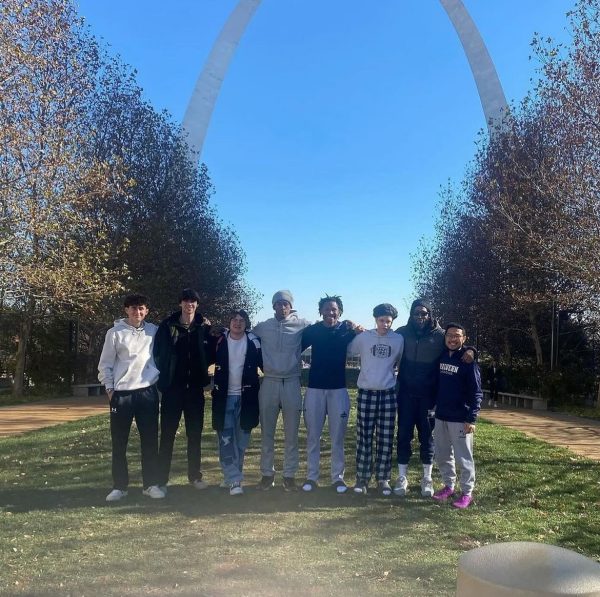History of the Arts at Malvern Prep
Malvern’s longest standing art teacher takes a trip down memory lane to rediscover the rich history of Malvern’s Art Department.
The Arts Department is a very significant part of Malvern’s curriculum, but it wasn’t always that way.
In recent years, Malvern Prep has gone through many major changes, which is nothing new, given its broad history.
Ms. Jackie White, Upper School Visual Arts teacher and 9th Grade Academy Leader, has been at Malvern Prep for over twenty-five years, and has been a very influential part in creating Malvern Preparatory’s art program.
With the help of many different art teachers, all with various points of expertise, White was able to get an arts program off the ground, one that would evolve into a cornerstone of Malvern’s image.
“I was hired in the fall of ‘95,” said White. “There was an arts program, but it was mainly geared to the middle school and the high school was basically whenever you had [an] open and you had free [time], you could do art, [but] they didn’t have a structured class,” she continued.
At the time, White already had a full time job, but that didn’t stop her.
“I had another job, full time job at the same time, and the other one had an arts program already, pretty much on target, it was already going. Then there was Malvern and they had nothing [at the time] but I always like a challenge,” White said. “I know that I’m very passionate about the arts and what it can do for people and I thought, you know, I’ll give this a whirl. I’ll take the challenge and see what I can do,” she continued.
When White joined the Malvern community in 1995, the art program was drastically different then what it is today.
Before the Duffy Arts Center, all of the art classrooms, both music and visual arts were housed in Tolentine, very different from what it is like today. The visual art classrooms were on the top floor of Tolentine, while the music rooms were on the bottom floor.
“Because there was really no structure it was really hard to structure any kind of lessons and it was all really, really individual,” White said.
Unlike how art classes are set as one of the eight core classes, the classroom was used as an open studio where students could sign up for a time and work on their pieces. White even brought a ceramics wheel from home for the students to use; she later saw it as a game changer.
During White’s first year at Malvern, former Headmaster, Mr. Jim Stewart Sr. met with her to discuss a long term plan for the arts program as well as his thoughts on growing the department.
“When I talked to Mr. Stewart Sr. I said in order for it to grow, we need to make [visual arts] part of the curriculum,” White said.
Stewart wanted White to draw up a ten year plan for the arts program, which she said mainly focused on curriculum, and is something that she actually still has with her today.
“I think it was during my second year [that] we instituted classes, actual classes, what they are now for high school,” she said.
“Then after my second year, I was part of the revamping of Tolentine,” White said. “Because [at the time] the arts program did start to grow, and the facilities weren’t up to snuff; not just because of the art, but because the building just needed a change,” she said.
Similarly to the time when the CSI was built, the art classes had to be relocated for the time being, until construction was done.
“While they renovated Tolentine [1997], I would say it was my third year [at Malvern]. I taught out of Stewart Hall, which was just a gym, at the time, for a whole year long,” White said.
Now with the visual arts program beginning to develop, White needed to find a space to hold an art show, showcasing her students’ work. She decided that Vasey Hall, the auditorium prior to Duffy, would be a good spot.
“I asked during one of the concerts, if I could put up some artwork,” White said. “They’d never had art shows before, so it was a cinder block wall and I think I made it pretty good; that was our first art show,” she continued.
After taking a year to teach in Stewart, White returned her art classes back to a newly renovated Tolentine, however, the rooms were not perfect. Art classes were held on the top floor of Tolentine, yet the rooms were small and narrow, with minimal room to work with.
“Three years in we really started dispelling the idea or notion that people couldn’t do the arts, that you had to have a certain level of talent,” White said. “[With a lot of help from some board members,] that notion started to go away.”
White was pleased with the response that she was receiving from students early on, as more students continued to take part in her art classes.
“I’d say the culture of the school changed, it was more accepting and it was more accepting of the role that the arts did have [on campus], it did make a difference. It wasn’t just for the chosen few,” White said. “It didn’t matter if you weren’t a good drawer, it wasn’t about that; it was about what you can do with the materials and how you look at things differently,” she said.
Eager to continue her vision, White returned to Tolentine with big plans to make the art program larger than it had ever been before.
“After it [Tolentine] was renovated, then my plan was to get all these different styles,” White said. “We’re getting a jazz band, choir. I had it renovated, so we have photography, ceramics room, computer graphics room, and then studio arts room and then a middle school room,” White continued.
White said how the program was what she envisioned just to help get it growing. It consisted of most of the art classes currently offered at Malvern, all compiled in one floor of Tolentine.
The music side of the arts was very similar to the visual arts; they started out very small, but eventually blossomed into a full fledged part of the school.
When White first came to Malvern, “We did have a very small music program, just a small jazz band and we gave a few lessons,” she said.
With a renovated Tolentine Hall and a more enthused student body, the jazz band grew and a school choir was born.
“I just hired a bunch of really great people that have been here since and they [all] took their speciality and just pushed it,” White said. “Jackie Cantor with photography, Rob Muntz with 2D [studio arts], and I was mostly ceramics, at the time and we all helped out with middle school. And then, we got Mr. DelPizzo first and then Mr. Liga,” she continued.
White explained how they never had a choir at Malvern before, but one they did, “that was a big thing,” for the arts program as a whole.
At the time, Mr. Richard Roper, English teacher and College Counselor, was the theater director from 1976 until 2011. Now the Malvern Theatre Society, known as MTS, is directed by Dr. Jim Fry, Director of Student Life.
As years went by, the art program continued to grow and grow and more students began to get involved.
“We were using the hallways for classes, putting shelving in the hallways, and hanging art out there,” White said. “And the hallways and classrooms were really, really small, they weren’t as big as they are now,” she continued.
White said, “We were busting out of the seams. It was kind of what we have now, but all on that one floor.”
While space was tight, White and her fellow art teachers made due with the materials they had and really enjoyed the classes in Tolentine.
“Everything was really tight, it was great though. We were all right there with each other, so there was something nice about it,” White said. “There were no doors really in between, so we got to know each other really well.”
It was around 2005, that White’s original ten year plan was coming to an end. Since her first year there, she was able to grow the art program from one little visual arts room and one small band room, to having about five various art classes along with a school band and performing choir.
“When that building [Tolentine] was renovated, it was a big deal,” White said. “Up until that point it was only that one [pottery] wheel, but after we renovated, I think we had twelve wheels and it was very, very tight,” she continued.
“I think putting in that ceramics wheel and just bringing it to life, that really sealed the deal for a lot of people,” White added.
To many, that would be enough, but White and her team had bigger ambitions and were not even close to maximizing the art program’s full potential.
Then, an idea began to arise; to create a new building, which would be home to a flourishing arts department. A state of the arts building for the art, music and theater programs to expand, was the intention.
There was growing excitement amongst all the art teachers, faculty, staff and students for the “new building.” Embarking on a new journey which would end up to be a great success in Malvern’s history, the Duffy Arts Center began construction in 2006.
White herself had a few design details in mind for the building and she knew from her time in Tolentine what needed to be added that wasn’t in the previous art rooms.
“[In Tolentine], the music part was at the bottom [floor], and that should have been at the top; you need music to go up and out, which is why we made sure that the music was on the top floor and the visual arts are on the first floor,” White said.
Along with a few specifics about how the building show was laid out, White also made sure that the space looked open and inviting.
White said, “[In order to keep the same energy going], we’re going to make sure it [Duffy] has a lot of glass, so we can see each other and feed off each other. And I think it worked out pretty well.”
White also made note that the art shows were then moved to Stewart Hall, where it would be an all night affair with food, art displays and musical performances.
The state of the art building was named The Rev. David J. Duffy, OSA Center for the Arts, after former Headmaster and President of Malvern, Fr. David Duffy. His legacy towards the school remains prevalent today, now with a building holding his name, along with his portrait, which hangs proudly in the beautiful, new building.
Construction for Duffy was completed in 2008 and was ready to be moved into by March of that year. The building, which now serves as a focal point for Malvern’s campus is a far cry from that tiny art classroom, which White started with, in Tolentine.
“When I first came here, it was an all boys Catholic school, no arts program, but they wanted to start one, to actually have a program,” White said. “I was just so excited when it took off in Tolentine and it was doing so well. I didn’t think we would be moving from there into our own building. Never, ever thought about that,” she said.
The brand new arts center stood tall and brought, right at the center of Malvern’s campus. The new structure was placed right where Vasey Hall, the old auditorium was. The Duffy Arts Center, however, was both impressive in design as well as space inside.
At the center of the building, there is a 585 seat theater with its own Set Shop and Costume Shop for the theater program. The building also includes a Recording Studio, where students can create their own music, a Jazz/band Studio, along with a Choral Room and practice space for musicians.
On the Visual Arts side, the building includes a multi-purpose Studio Arts room, a Ceramics Studio, fitter with fifteen pottery wheels and kilns, and a Sculpture Shop. The building is also equipped with a Computer and Photography Lab, which has its own dark room, used for both traditional and digital photography.
Even today, White and the arts department are still trying to expand the program further.
“Even though we haven’t gotten dance classes, we have gotten close to it,” White said. “That’s one thing I would really love to see still happen, is having dance classes.”
Whether or not students would enjoy having dance classes is an open question, but White still tries to find ways she can bring the Malvern art department and expand into the community.
“I’m constantly thinking of ways to utilize the arts, as far as Christian service, working with other schools, working with other communities, bringing in more artists, to be a part of the school. All that and working with the rest of the department. Just trying to think what we can do to keep it alive and keep it current,” White said. “I think the arts are always current because we’re always pushing the envelope.”
Looking back at what White has been able to be a part of through her time with Malvern, it is pretty incredible. She noted that the whole process of building an arts program was a lot of fun, it was also a lot of work, but it was fun,” she said.
“Bringing in the arts … really did change the culture. You look that we have people working on the [athletic] fields and then they are doing other things that are technical and they still enjoy and get a lot out of it [arts program],” White said.
With the several different art programs Malvern had to offer, from Studio Arts to Choir, many students find themselves in the Duffy Arts Center multiple times a day.
“The arts really can influence and enhance students, their life and education. And that is something that we all had a hand in,” White said.
“I think the most interesting part is just how students gravitated towards [the arts] and got into it. I think it solidified the idea that there is that right side of your brain that needs to be educated just as much as your left side of the brain, and it’s not so black and white,” White explained
White had really made clear her passion for the arts and the idea that students show try to expose themselves to new things and try something new.
Coming from a small art classroom to an entire arts building is something that doesn’t happen overnight. White made sure to emphasise that this was not her doing alone. She had the help of a phenomenal art staff, each with something different to offer to Malvern’s community.
White said, “The biggest thing for me, that’s important, is not what I did, but to see people get into it, and notice the change in themselves and in what they’re doing and just what they can do [in regards to their art classes].”


